Issues and Challenges of PA in Malaysian Educational Institutions
VerifiedAdded on 2022/08/25
|42
|10815
|32
Report
AI Summary
This report investigates the challenges and issues of performance appraisal within Malaysian educational institutions. It begins by highlighting the importance of performance appraisal in improving employee performance, especially in the context of educational settings. The study examines the current practices, including the types of appraisal methods used and the challenges faced by teachers, such as underpayment and additional responsibilities. The research utilizes a single research design with primary data collected from 70 respondents to assess the effectiveness of the existing performance appraisal systems. The findings reveal that the current appraisal methods are not accurately evaluating teacher performance and fail to include crucial factors. The report also provides a comprehensive literature review that covers performance appraisal, its types, and associated challenges. The research methodology, including the research design, sampling, instrumentation, data collection, and data analysis, is described in detail. Finally, the report concludes with recommendations for improving the performance appraisal system in Malaysia, addressing the identified challenges and aiming to enhance the quality of education.

Running head: HUMAN RESOURCE MANAGEMENT
Human Resource Management
Name of the student
Name of the university
Author note
Human Resource Management
Name of the student
Name of the university
Author note
Paraphrase This Document
Need a fresh take? Get an instant paraphrase of this document with our AI Paraphraser

1HUMAN RESOURCE MANAGEMENT
Abstract
This report had evaluated the challenges and issues faced in performance appraisal in the
Malaysian educational institutes. The fundamental nature of the industry is quite different from
the performance appraisal system in business sector. The global education industry had faced
significant issues in effective implementing the concept of performance appraisal whereas
performance appraisal had become a key aspect in improving the employee performances in
modern organisations. Teachers had gone through underpayment in the industry which is one of
the reasons that fresh graduates, out of their universities are not interested in teaching as a
profession. The teachers in the industry had faced significant changes which had degraded the
quality of education in Malaysia. The research had used a single research design and collected
primary data from 70 respondents working in the educational institutes to understand the
effectiveness and issues of performance appraisal system. The results showed that performance
appraisal used in the industry are not accurate method of evaluating the performance of the
teachers and there are various factors not included in the process.
Abstract
This report had evaluated the challenges and issues faced in performance appraisal in the
Malaysian educational institutes. The fundamental nature of the industry is quite different from
the performance appraisal system in business sector. The global education industry had faced
significant issues in effective implementing the concept of performance appraisal whereas
performance appraisal had become a key aspect in improving the employee performances in
modern organisations. Teachers had gone through underpayment in the industry which is one of
the reasons that fresh graduates, out of their universities are not interested in teaching as a
profession. The teachers in the industry had faced significant changes which had degraded the
quality of education in Malaysia. The research had used a single research design and collected
primary data from 70 respondents working in the educational institutes to understand the
effectiveness and issues of performance appraisal system. The results showed that performance
appraisal used in the industry are not accurate method of evaluating the performance of the
teachers and there are various factors not included in the process.
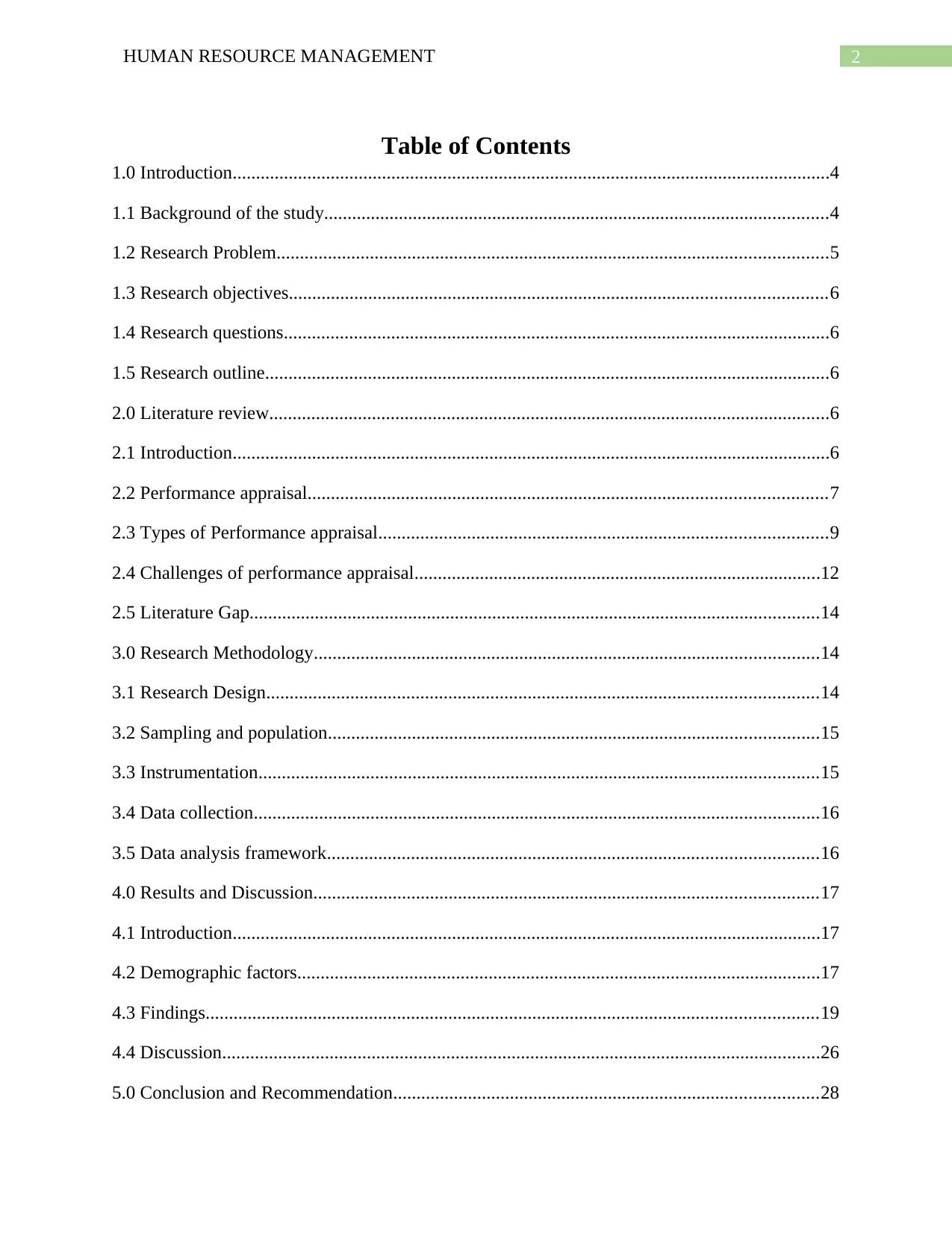
2HUMAN RESOURCE MANAGEMENT
Table of Contents
1.0 Introduction................................................................................................................................4
1.1 Background of the study............................................................................................................4
1.2 Research Problem......................................................................................................................5
1.3 Research objectives...................................................................................................................6
1.4 Research questions.....................................................................................................................6
1.5 Research outline.........................................................................................................................6
2.0 Literature review........................................................................................................................6
2.1 Introduction................................................................................................................................6
2.2 Performance appraisal...............................................................................................................7
2.3 Types of Performance appraisal................................................................................................9
2.4 Challenges of performance appraisal.......................................................................................12
2.5 Literature Gap..........................................................................................................................14
3.0 Research Methodology............................................................................................................14
3.1 Research Design......................................................................................................................14
3.2 Sampling and population.........................................................................................................15
3.3 Instrumentation........................................................................................................................15
3.4 Data collection.........................................................................................................................16
3.5 Data analysis framework.........................................................................................................16
4.0 Results and Discussion............................................................................................................17
4.1 Introduction..............................................................................................................................17
4.2 Demographic factors................................................................................................................17
4.3 Findings...................................................................................................................................19
4.4 Discussion................................................................................................................................26
5.0 Conclusion and Recommendation...........................................................................................28
Table of Contents
1.0 Introduction................................................................................................................................4
1.1 Background of the study............................................................................................................4
1.2 Research Problem......................................................................................................................5
1.3 Research objectives...................................................................................................................6
1.4 Research questions.....................................................................................................................6
1.5 Research outline.........................................................................................................................6
2.0 Literature review........................................................................................................................6
2.1 Introduction................................................................................................................................6
2.2 Performance appraisal...............................................................................................................7
2.3 Types of Performance appraisal................................................................................................9
2.4 Challenges of performance appraisal.......................................................................................12
2.5 Literature Gap..........................................................................................................................14
3.0 Research Methodology............................................................................................................14
3.1 Research Design......................................................................................................................14
3.2 Sampling and population.........................................................................................................15
3.3 Instrumentation........................................................................................................................15
3.4 Data collection.........................................................................................................................16
3.5 Data analysis framework.........................................................................................................16
4.0 Results and Discussion............................................................................................................17
4.1 Introduction..............................................................................................................................17
4.2 Demographic factors................................................................................................................17
4.3 Findings...................................................................................................................................19
4.4 Discussion................................................................................................................................26
5.0 Conclusion and Recommendation...........................................................................................28
⊘ This is a preview!⊘
Do you want full access?
Subscribe today to unlock all pages.

Trusted by 1+ million students worldwide
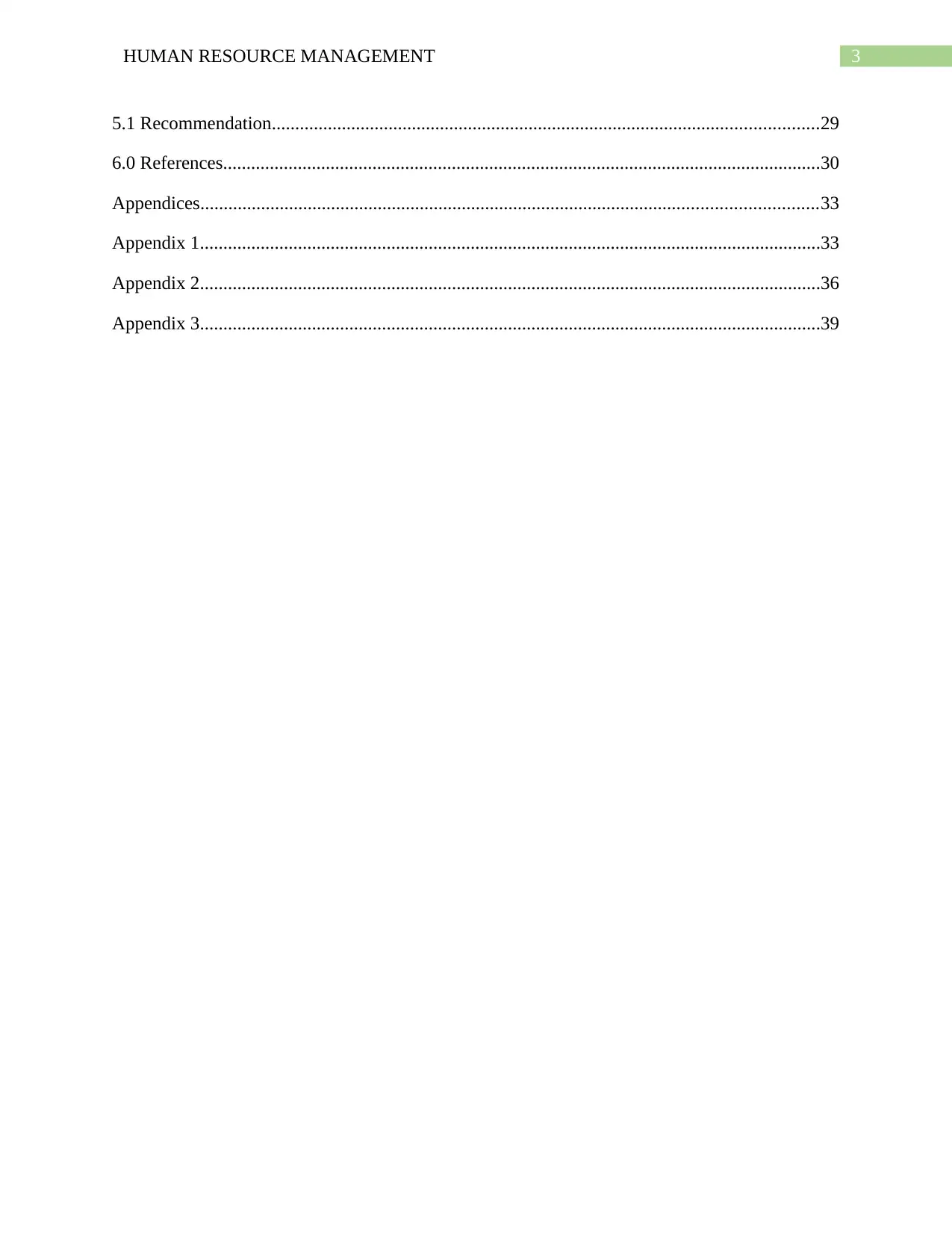
3HUMAN RESOURCE MANAGEMENT
5.1 Recommendation.....................................................................................................................29
6.0 References................................................................................................................................30
Appendices....................................................................................................................................33
Appendix 1.....................................................................................................................................33
Appendix 2.....................................................................................................................................36
Appendix 3.....................................................................................................................................39
5.1 Recommendation.....................................................................................................................29
6.0 References................................................................................................................................30
Appendices....................................................................................................................................33
Appendix 1.....................................................................................................................................33
Appendix 2.....................................................................................................................................36
Appendix 3.....................................................................................................................................39
Paraphrase This Document
Need a fresh take? Get an instant paraphrase of this document with our AI Paraphraser
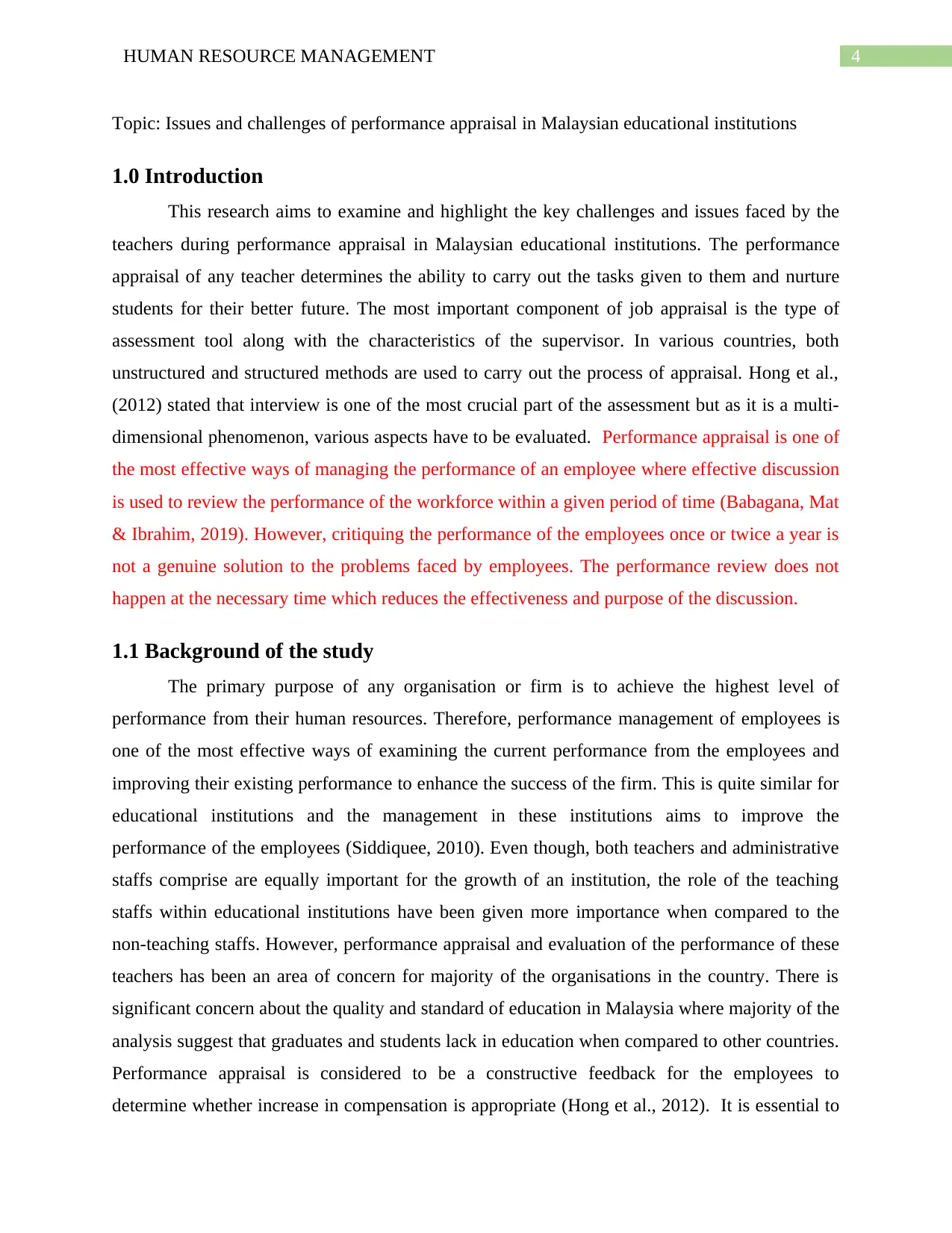
4HUMAN RESOURCE MANAGEMENT
Topic: Issues and challenges of performance appraisal in Malaysian educational institutions
1.0 Introduction
This research aims to examine and highlight the key challenges and issues faced by the
teachers during performance appraisal in Malaysian educational institutions. The performance
appraisal of any teacher determines the ability to carry out the tasks given to them and nurture
students for their better future. The most important component of job appraisal is the type of
assessment tool along with the characteristics of the supervisor. In various countries, both
unstructured and structured methods are used to carry out the process of appraisal. Hong et al.,
(2012) stated that interview is one of the most crucial part of the assessment but as it is a multi-
dimensional phenomenon, various aspects have to be evaluated. Performance appraisal is one of
the most effective ways of managing the performance of an employee where effective discussion
is used to review the performance of the workforce within a given period of time (Babagana, Mat
& Ibrahim, 2019). However, critiquing the performance of the employees once or twice a year is
not a genuine solution to the problems faced by employees. The performance review does not
happen at the necessary time which reduces the effectiveness and purpose of the discussion.
1.1 Background of the study
The primary purpose of any organisation or firm is to achieve the highest level of
performance from their human resources. Therefore, performance management of employees is
one of the most effective ways of examining the current performance from the employees and
improving their existing performance to enhance the success of the firm. This is quite similar for
educational institutions and the management in these institutions aims to improve the
performance of the employees (Siddiquee, 2010). Even though, both teachers and administrative
staffs comprise are equally important for the growth of an institution, the role of the teaching
staffs within educational institutions have been given more importance when compared to the
non-teaching staffs. However, performance appraisal and evaluation of the performance of these
teachers has been an area of concern for majority of the organisations in the country. There is
significant concern about the quality and standard of education in Malaysia where majority of the
analysis suggest that graduates and students lack in education when compared to other countries.
Performance appraisal is considered to be a constructive feedback for the employees to
determine whether increase in compensation is appropriate (Hong et al., 2012). It is essential to
Topic: Issues and challenges of performance appraisal in Malaysian educational institutions
1.0 Introduction
This research aims to examine and highlight the key challenges and issues faced by the
teachers during performance appraisal in Malaysian educational institutions. The performance
appraisal of any teacher determines the ability to carry out the tasks given to them and nurture
students for their better future. The most important component of job appraisal is the type of
assessment tool along with the characteristics of the supervisor. In various countries, both
unstructured and structured methods are used to carry out the process of appraisal. Hong et al.,
(2012) stated that interview is one of the most crucial part of the assessment but as it is a multi-
dimensional phenomenon, various aspects have to be evaluated. Performance appraisal is one of
the most effective ways of managing the performance of an employee where effective discussion
is used to review the performance of the workforce within a given period of time (Babagana, Mat
& Ibrahim, 2019). However, critiquing the performance of the employees once or twice a year is
not a genuine solution to the problems faced by employees. The performance review does not
happen at the necessary time which reduces the effectiveness and purpose of the discussion.
1.1 Background of the study
The primary purpose of any organisation or firm is to achieve the highest level of
performance from their human resources. Therefore, performance management of employees is
one of the most effective ways of examining the current performance from the employees and
improving their existing performance to enhance the success of the firm. This is quite similar for
educational institutions and the management in these institutions aims to improve the
performance of the employees (Siddiquee, 2010). Even though, both teachers and administrative
staffs comprise are equally important for the growth of an institution, the role of the teaching
staffs within educational institutions have been given more importance when compared to the
non-teaching staffs. However, performance appraisal and evaluation of the performance of these
teachers has been an area of concern for majority of the organisations in the country. There is
significant concern about the quality and standard of education in Malaysia where majority of the
analysis suggest that graduates and students lack in education when compared to other countries.
Performance appraisal is considered to be a constructive feedback for the employees to
determine whether increase in compensation is appropriate (Hong et al., 2012). It is essential to
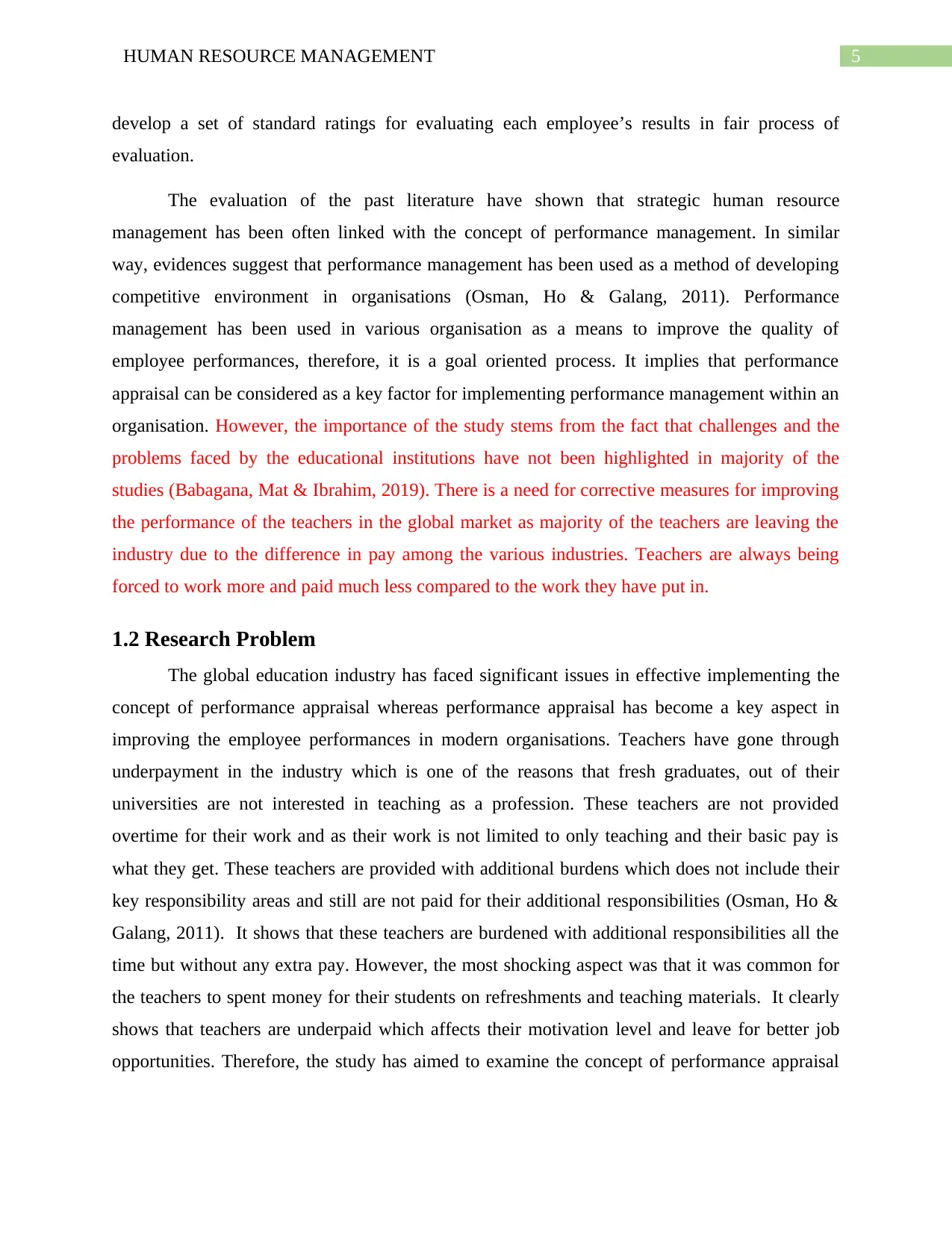
5HUMAN RESOURCE MANAGEMENT
develop a set of standard ratings for evaluating each employee’s results in fair process of
evaluation.
The evaluation of the past literature have shown that strategic human resource
management has been often linked with the concept of performance management. In similar
way, evidences suggest that performance management has been used as a method of developing
competitive environment in organisations (Osman, Ho & Galang, 2011). Performance
management has been used in various organisation as a means to improve the quality of
employee performances, therefore, it is a goal oriented process. It implies that performance
appraisal can be considered as a key factor for implementing performance management within an
organisation. However, the importance of the study stems from the fact that challenges and the
problems faced by the educational institutions have not been highlighted in majority of the
studies (Babagana, Mat & Ibrahim, 2019). There is a need for corrective measures for improving
the performance of the teachers in the global market as majority of the teachers are leaving the
industry due to the difference in pay among the various industries. Teachers are always being
forced to work more and paid much less compared to the work they have put in.
1.2 Research Problem
The global education industry has faced significant issues in effective implementing the
concept of performance appraisal whereas performance appraisal has become a key aspect in
improving the employee performances in modern organisations. Teachers have gone through
underpayment in the industry which is one of the reasons that fresh graduates, out of their
universities are not interested in teaching as a profession. These teachers are not provided
overtime for their work and as their work is not limited to only teaching and their basic pay is
what they get. These teachers are provided with additional burdens which does not include their
key responsibility areas and still are not paid for their additional responsibilities (Osman, Ho &
Galang, 2011). It shows that these teachers are burdened with additional responsibilities all the
time but without any extra pay. However, the most shocking aspect was that it was common for
the teachers to spent money for their students on refreshments and teaching materials. It clearly
shows that teachers are underpaid which affects their motivation level and leave for better job
opportunities. Therefore, the study has aimed to examine the concept of performance appraisal
develop a set of standard ratings for evaluating each employee’s results in fair process of
evaluation.
The evaluation of the past literature have shown that strategic human resource
management has been often linked with the concept of performance management. In similar
way, evidences suggest that performance management has been used as a method of developing
competitive environment in organisations (Osman, Ho & Galang, 2011). Performance
management has been used in various organisation as a means to improve the quality of
employee performances, therefore, it is a goal oriented process. It implies that performance
appraisal can be considered as a key factor for implementing performance management within an
organisation. However, the importance of the study stems from the fact that challenges and the
problems faced by the educational institutions have not been highlighted in majority of the
studies (Babagana, Mat & Ibrahim, 2019). There is a need for corrective measures for improving
the performance of the teachers in the global market as majority of the teachers are leaving the
industry due to the difference in pay among the various industries. Teachers are always being
forced to work more and paid much less compared to the work they have put in.
1.2 Research Problem
The global education industry has faced significant issues in effective implementing the
concept of performance appraisal whereas performance appraisal has become a key aspect in
improving the employee performances in modern organisations. Teachers have gone through
underpayment in the industry which is one of the reasons that fresh graduates, out of their
universities are not interested in teaching as a profession. These teachers are not provided
overtime for their work and as their work is not limited to only teaching and their basic pay is
what they get. These teachers are provided with additional burdens which does not include their
key responsibility areas and still are not paid for their additional responsibilities (Osman, Ho &
Galang, 2011). It shows that these teachers are burdened with additional responsibilities all the
time but without any extra pay. However, the most shocking aspect was that it was common for
the teachers to spent money for their students on refreshments and teaching materials. It clearly
shows that teachers are underpaid which affects their motivation level and leave for better job
opportunities. Therefore, the study has aimed to examine the concept of performance appraisal
⊘ This is a preview!⊘
Do you want full access?
Subscribe today to unlock all pages.

Trusted by 1+ million students worldwide
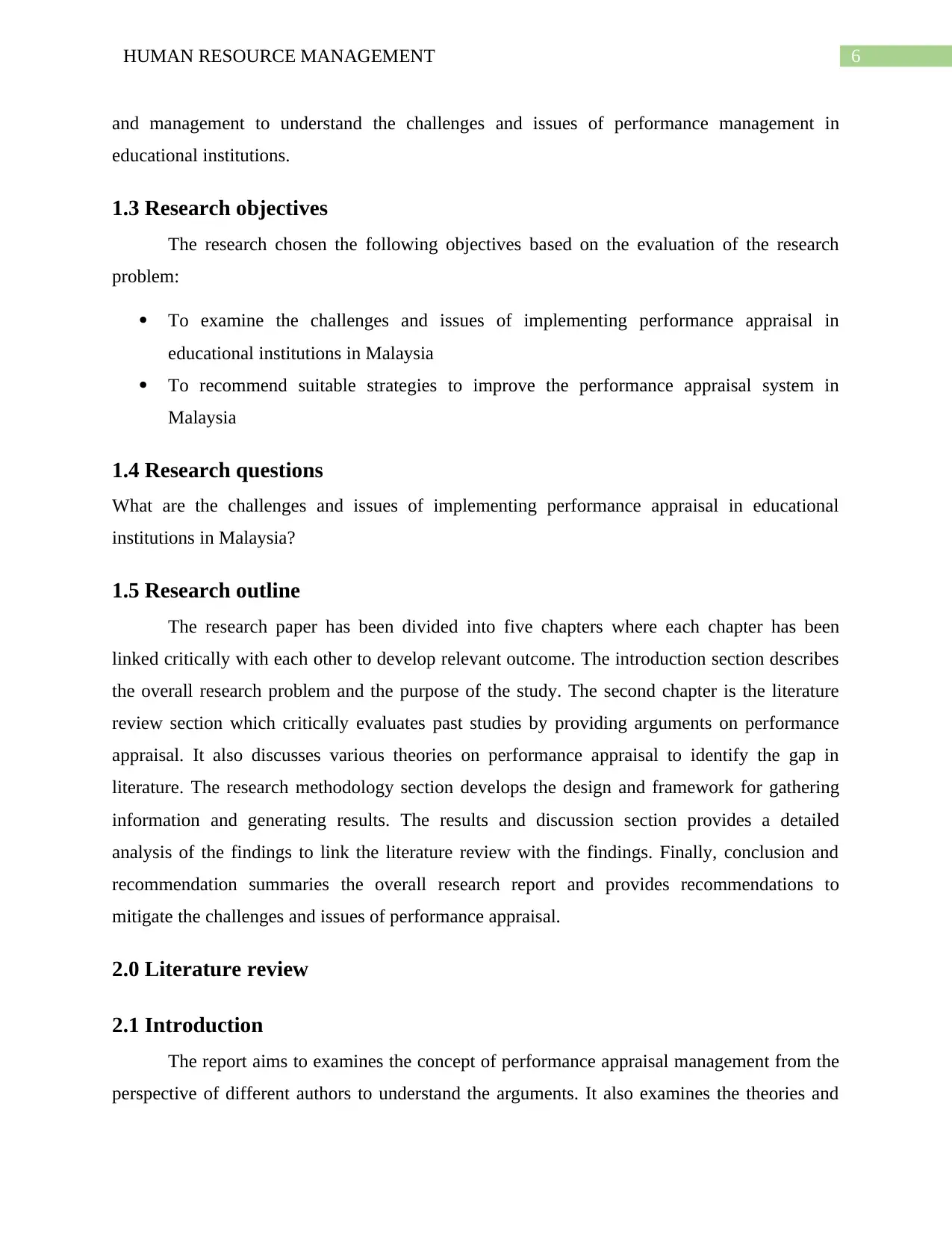
6HUMAN RESOURCE MANAGEMENT
and management to understand the challenges and issues of performance management in
educational institutions.
1.3 Research objectives
The research chosen the following objectives based on the evaluation of the research
problem:
To examine the challenges and issues of implementing performance appraisal in
educational institutions in Malaysia
To recommend suitable strategies to improve the performance appraisal system in
Malaysia
1.4 Research questions
What are the challenges and issues of implementing performance appraisal in educational
institutions in Malaysia?
1.5 Research outline
The research paper has been divided into five chapters where each chapter has been
linked critically with each other to develop relevant outcome. The introduction section describes
the overall research problem and the purpose of the study. The second chapter is the literature
review section which critically evaluates past studies by providing arguments on performance
appraisal. It also discusses various theories on performance appraisal to identify the gap in
literature. The research methodology section develops the design and framework for gathering
information and generating results. The results and discussion section provides a detailed
analysis of the findings to link the literature review with the findings. Finally, conclusion and
recommendation summaries the overall research report and provides recommendations to
mitigate the challenges and issues of performance appraisal.
2.0 Literature review
2.1 Introduction
The report aims to examines the concept of performance appraisal management from the
perspective of different authors to understand the arguments. It also examines the theories and
and management to understand the challenges and issues of performance management in
educational institutions.
1.3 Research objectives
The research chosen the following objectives based on the evaluation of the research
problem:
To examine the challenges and issues of implementing performance appraisal in
educational institutions in Malaysia
To recommend suitable strategies to improve the performance appraisal system in
Malaysia
1.4 Research questions
What are the challenges and issues of implementing performance appraisal in educational
institutions in Malaysia?
1.5 Research outline
The research paper has been divided into five chapters where each chapter has been
linked critically with each other to develop relevant outcome. The introduction section describes
the overall research problem and the purpose of the study. The second chapter is the literature
review section which critically evaluates past studies by providing arguments on performance
appraisal. It also discusses various theories on performance appraisal to identify the gap in
literature. The research methodology section develops the design and framework for gathering
information and generating results. The results and discussion section provides a detailed
analysis of the findings to link the literature review with the findings. Finally, conclusion and
recommendation summaries the overall research report and provides recommendations to
mitigate the challenges and issues of performance appraisal.
2.0 Literature review
2.1 Introduction
The report aims to examines the concept of performance appraisal management from the
perspective of different authors to understand the arguments. It also examines the theories and
Paraphrase This Document
Need a fresh take? Get an instant paraphrase of this document with our AI Paraphraser
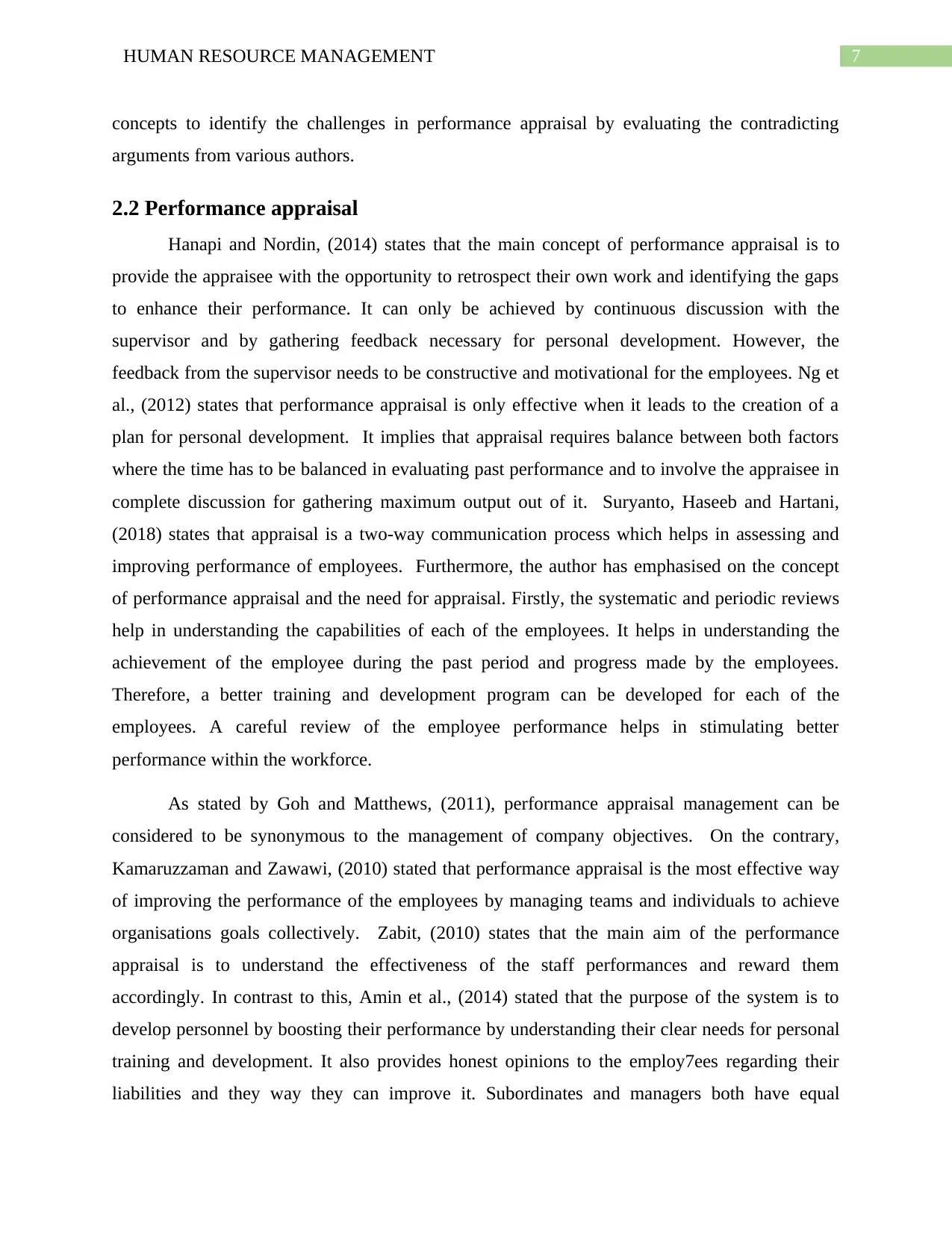
7HUMAN RESOURCE MANAGEMENT
concepts to identify the challenges in performance appraisal by evaluating the contradicting
arguments from various authors.
2.2 Performance appraisal
Hanapi and Nordin, (2014) states that the main concept of performance appraisal is to
provide the appraisee with the opportunity to retrospect their own work and identifying the gaps
to enhance their performance. It can only be achieved by continuous discussion with the
supervisor and by gathering feedback necessary for personal development. However, the
feedback from the supervisor needs to be constructive and motivational for the employees. Ng et
al., (2012) states that performance appraisal is only effective when it leads to the creation of a
plan for personal development. It implies that appraisal requires balance between both factors
where the time has to be balanced in evaluating past performance and to involve the appraisee in
complete discussion for gathering maximum output out of it. Suryanto, Haseeb and Hartani,
(2018) states that appraisal is a two-way communication process which helps in assessing and
improving performance of employees. Furthermore, the author has emphasised on the concept
of performance appraisal and the need for appraisal. Firstly, the systematic and periodic reviews
help in understanding the capabilities of each of the employees. It helps in understanding the
achievement of the employee during the past period and progress made by the employees.
Therefore, a better training and development program can be developed for each of the
employees. A careful review of the employee performance helps in stimulating better
performance within the workforce.
As stated by Goh and Matthews, (2011), performance appraisal management can be
considered to be synonymous to the management of company objectives. On the contrary,
Kamaruzzaman and Zawawi, (2010) stated that performance appraisal is the most effective way
of improving the performance of the employees by managing teams and individuals to achieve
organisations goals collectively. Zabit, (2010) states that the main aim of the performance
appraisal is to understand the effectiveness of the staff performances and reward them
accordingly. In contrast to this, Amin et al., (2014) stated that the purpose of the system is to
develop personnel by boosting their performance by understanding their clear needs for personal
training and development. It also provides honest opinions to the employ7ees regarding their
liabilities and they way they can improve it. Subordinates and managers both have equal
concepts to identify the challenges in performance appraisal by evaluating the contradicting
arguments from various authors.
2.2 Performance appraisal
Hanapi and Nordin, (2014) states that the main concept of performance appraisal is to
provide the appraisee with the opportunity to retrospect their own work and identifying the gaps
to enhance their performance. It can only be achieved by continuous discussion with the
supervisor and by gathering feedback necessary for personal development. However, the
feedback from the supervisor needs to be constructive and motivational for the employees. Ng et
al., (2012) states that performance appraisal is only effective when it leads to the creation of a
plan for personal development. It implies that appraisal requires balance between both factors
where the time has to be balanced in evaluating past performance and to involve the appraisee in
complete discussion for gathering maximum output out of it. Suryanto, Haseeb and Hartani,
(2018) states that appraisal is a two-way communication process which helps in assessing and
improving performance of employees. Furthermore, the author has emphasised on the concept
of performance appraisal and the need for appraisal. Firstly, the systematic and periodic reviews
help in understanding the capabilities of each of the employees. It helps in understanding the
achievement of the employee during the past period and progress made by the employees.
Therefore, a better training and development program can be developed for each of the
employees. A careful review of the employee performance helps in stimulating better
performance within the workforce.
As stated by Goh and Matthews, (2011), performance appraisal management can be
considered to be synonymous to the management of company objectives. On the contrary,
Kamaruzzaman and Zawawi, (2010) stated that performance appraisal is the most effective way
of improving the performance of the employees by managing teams and individuals to achieve
organisations goals collectively. Zabit, (2010) states that the main aim of the performance
appraisal is to understand the effectiveness of the staff performances and reward them
accordingly. In contrast to this, Amin et al., (2014) stated that the purpose of the system is to
develop personnel by boosting their performance by understanding their clear needs for personal
training and development. It also provides honest opinions to the employ7ees regarding their
liabilities and they way they can improve it. Subordinates and managers both have equal

8HUMAN RESOURCE MANAGEMENT
responsibility so that the overall process works. Ibrahim et al., (2010) defined performance
appraisal as the process of evaluating the performance of the employees with some pre-
determined criteria and there are other factors such as accomplishments, organisational
behaviour, strengths and weaknesses which are evaluated to rate the performance of the
employee. Bouskila-Yam and Kluger, (2011) has provided three objectives of performance
appraisal and they are judgement evaluation, objective production and personal evaluation.
According to Suryanto, Haseeb and Hartani, (2018), performance appraisal has been
conducted annually in majority of the cases and there are various companies moving towards
shorter evaluation cycles it helps in continuous improvement of employees which positively
affects the performance of the organisation. Kamaruzzaman and Zawawi, (2010) states that
even though there are potential benefits of performance appraisal and there are significant
drawbacks of performance appraisal such as legal issues as there are multiple instances where
employees tend to remain dissatisfied with the evaluation made by the employees. According to
Zabit, (2010), the majority of the employees are not favouring the concept of formal appraisal as
ratings does not make them feel enthusiastic about it where the author argued that employees
having higher tenure should be provided with higher level job. However, Bouskila-Yam and
Kluger, (2011) contradicted the choice by stating that employees having higher job experience
does not necessarily possess the skills to hold higher positions.
It is a common phenomenon to give feedback to the consumers in modern organisations.
This type of review of the performance is described as "moves made by (an) outside operator
(s)to give data with respect to some aspect(s) of one's task performance”. Therefore, the
definition highlights that feedbacks are possible knowledge and information given to the
employees so that they are aware of their shortcomings and results of their work. Appraisal of
performance could fill in as a significant inspirational foundation for employees on the off
chance that it is led successfully (Bouskila-Yam and Kluger, 2011). Also, workers are keen on
appraisal of performance all together to know the extent to which they are fulfilling their job
role. Furthermore, giving (and getting) input is not a simple task and consist of various
complications. In the 1990s, Kluger and DeNisi (1996) published a broad survey which included
meta-analysis to examine the influence of performance appraisal. In this study, 131 articles were
used to identify 607 relationship identified on the articles between of 1905 and 1996 (Bouskila-
responsibility so that the overall process works. Ibrahim et al., (2010) defined performance
appraisal as the process of evaluating the performance of the employees with some pre-
determined criteria and there are other factors such as accomplishments, organisational
behaviour, strengths and weaknesses which are evaluated to rate the performance of the
employee. Bouskila-Yam and Kluger, (2011) has provided three objectives of performance
appraisal and they are judgement evaluation, objective production and personal evaluation.
According to Suryanto, Haseeb and Hartani, (2018), performance appraisal has been
conducted annually in majority of the cases and there are various companies moving towards
shorter evaluation cycles it helps in continuous improvement of employees which positively
affects the performance of the organisation. Kamaruzzaman and Zawawi, (2010) states that
even though there are potential benefits of performance appraisal and there are significant
drawbacks of performance appraisal such as legal issues as there are multiple instances where
employees tend to remain dissatisfied with the evaluation made by the employees. According to
Zabit, (2010), the majority of the employees are not favouring the concept of formal appraisal as
ratings does not make them feel enthusiastic about it where the author argued that employees
having higher tenure should be provided with higher level job. However, Bouskila-Yam and
Kluger, (2011) contradicted the choice by stating that employees having higher job experience
does not necessarily possess the skills to hold higher positions.
It is a common phenomenon to give feedback to the consumers in modern organisations.
This type of review of the performance is described as "moves made by (an) outside operator
(s)to give data with respect to some aspect(s) of one's task performance”. Therefore, the
definition highlights that feedbacks are possible knowledge and information given to the
employees so that they are aware of their shortcomings and results of their work. Appraisal of
performance could fill in as a significant inspirational foundation for employees on the off
chance that it is led successfully (Bouskila-Yam and Kluger, 2011). Also, workers are keen on
appraisal of performance all together to know the extent to which they are fulfilling their job
role. Furthermore, giving (and getting) input is not a simple task and consist of various
complications. In the 1990s, Kluger and DeNisi (1996) published a broad survey which included
meta-analysis to examine the influence of performance appraisal. In this study, 131 articles were
used to identify 607 relationship identified on the articles between of 1905 and 1996 (Bouskila-
⊘ This is a preview!⊘
Do you want full access?
Subscribe today to unlock all pages.

Trusted by 1+ million students worldwide
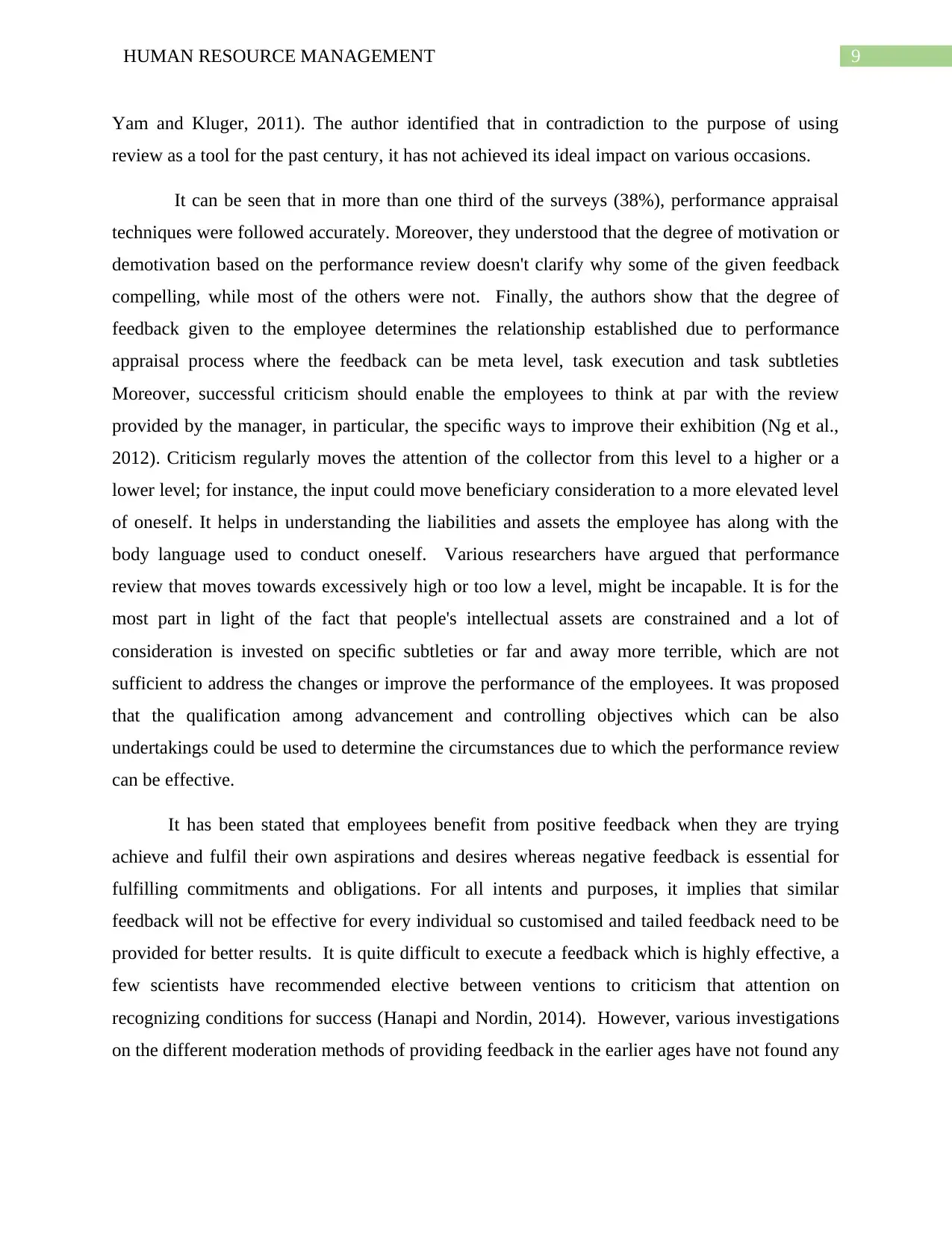
9HUMAN RESOURCE MANAGEMENT
Yam and Kluger, 2011). The author identified that in contradiction to the purpose of using
review as a tool for the past century, it has not achieved its ideal impact on various occasions.
It can be seen that in more than one third of the surveys (38%), performance appraisal
techniques were followed accurately. Moreover, they understood that the degree of motivation or
demotivation based on the performance review doesn't clarify why some of the given feedback
compelling, while most of the others were not. Finally, the authors show that the degree of
feedback given to the employee determines the relationship established due to performance
appraisal process where the feedback can be meta level, task execution and task subtleties
Moreover, successful criticism should enable the employees to think at par with the review
provided by the manager, in particular, the specific ways to improve their exhibition (Ng et al.,
2012). Criticism regularly moves the attention of the collector from this level to a higher or a
lower level; for instance, the input could move beneficiary consideration to a more elevated level
of oneself. It helps in understanding the liabilities and assets the employee has along with the
body language used to conduct oneself. Various researchers have argued that performance
review that moves towards excessively high or too low a level, might be incapable. It is for the
most part in light of the fact that people's intellectual assets are constrained and a lot of
consideration is invested on specific subtleties or far and away more terrible, which are not
sufficient to address the changes or improve the performance of the employees. It was proposed
that the qualification among advancement and controlling objectives which can be also
undertakings could be used to determine the circumstances due to which the performance review
can be effective.
It has been stated that employees benefit from positive feedback when they are trying
achieve and fulfil their own aspirations and desires whereas negative feedback is essential for
fulfilling commitments and obligations. For all intents and purposes, it implies that similar
feedback will not be effective for every individual so customised and tailed feedback need to be
provided for better results. It is quite difficult to execute a feedback which is highly effective, a
few scientists have recommended elective between ventions to criticism that attention on
recognizing conditions for success (Hanapi and Nordin, 2014). However, various investigations
on the different moderation methods of providing feedback in the earlier ages have not found any
Yam and Kluger, 2011). The author identified that in contradiction to the purpose of using
review as a tool for the past century, it has not achieved its ideal impact on various occasions.
It can be seen that in more than one third of the surveys (38%), performance appraisal
techniques were followed accurately. Moreover, they understood that the degree of motivation or
demotivation based on the performance review doesn't clarify why some of the given feedback
compelling, while most of the others were not. Finally, the authors show that the degree of
feedback given to the employee determines the relationship established due to performance
appraisal process where the feedback can be meta level, task execution and task subtleties
Moreover, successful criticism should enable the employees to think at par with the review
provided by the manager, in particular, the specific ways to improve their exhibition (Ng et al.,
2012). Criticism regularly moves the attention of the collector from this level to a higher or a
lower level; for instance, the input could move beneficiary consideration to a more elevated level
of oneself. It helps in understanding the liabilities and assets the employee has along with the
body language used to conduct oneself. Various researchers have argued that performance
review that moves towards excessively high or too low a level, might be incapable. It is for the
most part in light of the fact that people's intellectual assets are constrained and a lot of
consideration is invested on specific subtleties or far and away more terrible, which are not
sufficient to address the changes or improve the performance of the employees. It was proposed
that the qualification among advancement and controlling objectives which can be also
undertakings could be used to determine the circumstances due to which the performance review
can be effective.
It has been stated that employees benefit from positive feedback when they are trying
achieve and fulfil their own aspirations and desires whereas negative feedback is essential for
fulfilling commitments and obligations. For all intents and purposes, it implies that similar
feedback will not be effective for every individual so customised and tailed feedback need to be
provided for better results. It is quite difficult to execute a feedback which is highly effective, a
few scientists have recommended elective between ventions to criticism that attention on
recognizing conditions for success (Hanapi and Nordin, 2014). However, various investigations
on the different moderation methods of providing feedback in the earlier ages have not found any
Paraphrase This Document
Need a fresh take? Get an instant paraphrase of this document with our AI Paraphraser

10HUMAN RESOURCE MANAGEMENT
fruitful results. Therefore, it is essential to develop performance management processes that
improves the existing processes and provides options for creating a better process.
2.3 Types of Performance appraisal
Suryanto, Haseeb and Hartani, (2018) states that in majority of the cases, companies use
a periodic performance appraisal which includes variety of quantifiable, measurable metrics or
performance indicators. There are numerous types of performance appraisal approaches within
organisations and they are as follows:
Top down approach
It is the most common type of appraisal approaches and has been used by majority of the
organisations. It involves providing the employees with review of their performances and it is
more effective in case of performance where employees and managers work regularly which
helps in meeting the set goals of the performance. The key strengths and weaknesses of the
employees and the managers have been evaluated in the study.
Peer to Peer approach
This type of approach uses the review or opinion of the peers to review the performance
of a employees. It is an effective approach as the colleagues and co-workers better understand
the abilities along with their weaknesses. It is most effective for the team working together
where the employees are constantly working together on projects. However, there are drawbacks
to this type of group as it can lead to controversy when the team is immature.
360-degree approach
The 360-degree approach is the process where the employees provide anonymous
feedback to and from all the people working in the same environment. It helps in gathering and
giving feedback to peers, subordinates and supervisors at the same time. It includes evaluation
from 10 people which is filled in using online forms where the employee is rated on numerical
scale along with descriptive comments. It is very useful for managers and people not included in
the management role of the organisation.
Babagana, Mat and Ibrahim, (2019) states that there are different types of appraisal
methods which are focused on the different areas of performance. These methods are also
fruitful results. Therefore, it is essential to develop performance management processes that
improves the existing processes and provides options for creating a better process.
2.3 Types of Performance appraisal
Suryanto, Haseeb and Hartani, (2018) states that in majority of the cases, companies use
a periodic performance appraisal which includes variety of quantifiable, measurable metrics or
performance indicators. There are numerous types of performance appraisal approaches within
organisations and they are as follows:
Top down approach
It is the most common type of appraisal approaches and has been used by majority of the
organisations. It involves providing the employees with review of their performances and it is
more effective in case of performance where employees and managers work regularly which
helps in meeting the set goals of the performance. The key strengths and weaknesses of the
employees and the managers have been evaluated in the study.
Peer to Peer approach
This type of approach uses the review or opinion of the peers to review the performance
of a employees. It is an effective approach as the colleagues and co-workers better understand
the abilities along with their weaknesses. It is most effective for the team working together
where the employees are constantly working together on projects. However, there are drawbacks
to this type of group as it can lead to controversy when the team is immature.
360-degree approach
The 360-degree approach is the process where the employees provide anonymous
feedback to and from all the people working in the same environment. It helps in gathering and
giving feedback to peers, subordinates and supervisors at the same time. It includes evaluation
from 10 people which is filled in using online forms where the employee is rated on numerical
scale along with descriptive comments. It is very useful for managers and people not included in
the management role of the organisation.
Babagana, Mat and Ibrahim, (2019) states that there are different types of appraisal
methods which are focused on the different areas of performance. These methods are also
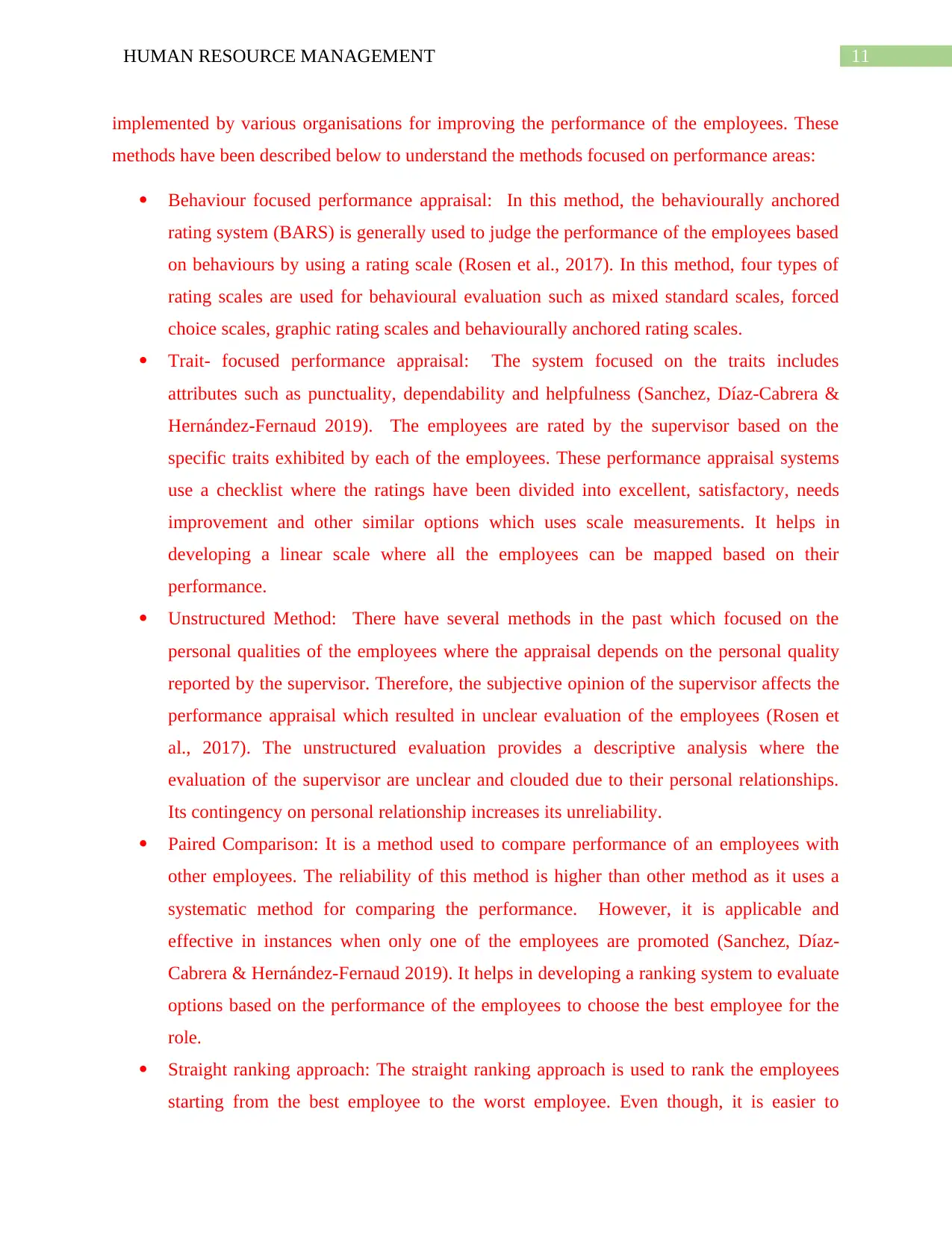
11HUMAN RESOURCE MANAGEMENT
implemented by various organisations for improving the performance of the employees. These
methods have been described below to understand the methods focused on performance areas:
Behaviour focused performance appraisal: In this method, the behaviourally anchored
rating system (BARS) is generally used to judge the performance of the employees based
on behaviours by using a rating scale (Rosen et al., 2017). In this method, four types of
rating scales are used for behavioural evaluation such as mixed standard scales, forced
choice scales, graphic rating scales and behaviourally anchored rating scales.
Trait- focused performance appraisal: The system focused on the traits includes
attributes such as punctuality, dependability and helpfulness (Sanchez, Díaz-Cabrera &
Hernández-Fernaud 2019). The employees are rated by the supervisor based on the
specific traits exhibited by each of the employees. These performance appraisal systems
use a checklist where the ratings have been divided into excellent, satisfactory, needs
improvement and other similar options which uses scale measurements. It helps in
developing a linear scale where all the employees can be mapped based on their
performance.
Unstructured Method: There have several methods in the past which focused on the
personal qualities of the employees where the appraisal depends on the personal quality
reported by the supervisor. Therefore, the subjective opinion of the supervisor affects the
performance appraisal which resulted in unclear evaluation of the employees (Rosen et
al., 2017). The unstructured evaluation provides a descriptive analysis where the
evaluation of the supervisor are unclear and clouded due to their personal relationships.
Its contingency on personal relationship increases its unreliability.
Paired Comparison: It is a method used to compare performance of an employees with
other employees. The reliability of this method is higher than other method as it uses a
systematic method for comparing the performance. However, it is applicable and
effective in instances when only one of the employees are promoted (Sanchez, Díaz-
Cabrera & Hernández-Fernaud 2019). It helps in developing a ranking system to evaluate
options based on the performance of the employees to choose the best employee for the
role.
Straight ranking approach: The straight ranking approach is used to rank the employees
starting from the best employee to the worst employee. Even though, it is easier to
implemented by various organisations for improving the performance of the employees. These
methods have been described below to understand the methods focused on performance areas:
Behaviour focused performance appraisal: In this method, the behaviourally anchored
rating system (BARS) is generally used to judge the performance of the employees based
on behaviours by using a rating scale (Rosen et al., 2017). In this method, four types of
rating scales are used for behavioural evaluation such as mixed standard scales, forced
choice scales, graphic rating scales and behaviourally anchored rating scales.
Trait- focused performance appraisal: The system focused on the traits includes
attributes such as punctuality, dependability and helpfulness (Sanchez, Díaz-Cabrera &
Hernández-Fernaud 2019). The employees are rated by the supervisor based on the
specific traits exhibited by each of the employees. These performance appraisal systems
use a checklist where the ratings have been divided into excellent, satisfactory, needs
improvement and other similar options which uses scale measurements. It helps in
developing a linear scale where all the employees can be mapped based on their
performance.
Unstructured Method: There have several methods in the past which focused on the
personal qualities of the employees where the appraisal depends on the personal quality
reported by the supervisor. Therefore, the subjective opinion of the supervisor affects the
performance appraisal which resulted in unclear evaluation of the employees (Rosen et
al., 2017). The unstructured evaluation provides a descriptive analysis where the
evaluation of the supervisor are unclear and clouded due to their personal relationships.
Its contingency on personal relationship increases its unreliability.
Paired Comparison: It is a method used to compare performance of an employees with
other employees. The reliability of this method is higher than other method as it uses a
systematic method for comparing the performance. However, it is applicable and
effective in instances when only one of the employees are promoted (Sanchez, Díaz-
Cabrera & Hernández-Fernaud 2019). It helps in developing a ranking system to evaluate
options based on the performance of the employees to choose the best employee for the
role.
Straight ranking approach: The straight ranking approach is used to rank the employees
starting from the best employee to the worst employee. Even though, it is easier to
⊘ This is a preview!⊘
Do you want full access?
Subscribe today to unlock all pages.

Trusted by 1+ million students worldwide
1 out of 42
Related Documents
Your All-in-One AI-Powered Toolkit for Academic Success.
+13062052269
info@desklib.com
Available 24*7 on WhatsApp / Email
![[object Object]](/_next/static/media/star-bottom.7253800d.svg)
Unlock your academic potential
Copyright © 2020–2025 A2Z Services. All Rights Reserved. Developed and managed by ZUCOL.





